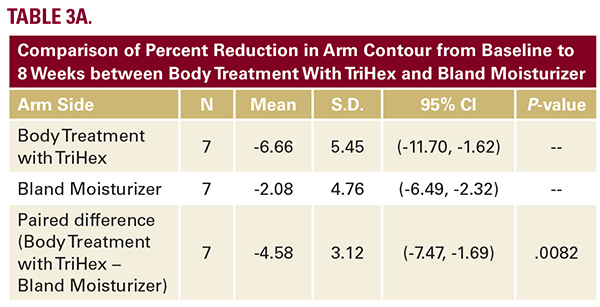Statistical Analysis
When subjected to independent statistical analysis, this small cohort demonstrated statistically significant results (P=0.0082) at 8 weeks.

Conclusion
The mean reduction in arm contour measurements from baseline to 8 weeks post treatment was 6.66% for body treatmentwith TriHex side and -2.08% for bland moisturizer side. The paired difference between body treatment with TriHex and bland moisturizer was -4.58%, which was statistically significant based on a paired t-test (P=0.0082). In other words, body treatment with TriHex is associated with a bigger reduction in arm contour than bland moisturizer, with statistical significance.

Conclusion
The mean reduction in arm contour measurements from baseline to 12 weeks post treatment was -5.58% for body treatmentwith TriHex side and -3.48% for bland moisturizer side. The paired difference between body treatment with TriHex and bland moisturizer was -2.10%, which was not statistically significant based on a paired t-test (P=0.1805).When subjected to independent statistical analysis, this small cohort demonstrated statistically significant results (P=0.0315) at 24 weeks.
Conclusion
The mean reduction in arm contour measurements from baseline to 24 weeks post treatment was -6.42 for body treatmentwith TriHex side and -2.17 for bland moisturizer side. The paired difference between body treatment with TriHex side and bland moisturizer was -4.26, which was statistically significant based on a paired t-test (P=0.0315).
DISCUSSION
Energy based non-surgical fat reduction is now an extremely popular procedure performed using varying technologies, either‘hot’ or ‘cold’. Cryolipolysis appears to be the most popular procedure performed in the US for this indication,2 although a host of new devices or technologies have been introduced to the market in recent years. The common thread among these devices is the damage to fat cell components with delivery of its contents and gradual elimination of these lipid droplets.4 It would appear that the lipolytic effect of these technologies all precipitate a change or disruption in the cell structure, which release mediators, particularly TNF-α, inducing lipolysis through intracellular signaling cascades, metabolites, and lipid dropletassociatedproteins.4,5Macrophages play important roles in the clearance of dead and dying cells, and in particular, of apoptotic cells.6 Lipid droplets are extremely large in size and challenging for the smaller macrophages to phagocytose. Fortunately, the process of autophagy is a great help in dealing with large intracellular components. Simply put, autophagy is the cell's way of repackaging very large organelles and intracellular bodies (such as lipid droplets) so that macrophages can cope with their digestion.7 This createssmaller components that can then be digested by macrophages. In recent years, studies have demonstrated that lipid droplets are taken up by autophagy to cope with lipid mobilization and droplet digestion. This process, termed lipophagy, specifically targets lipid droplets and adipose cellular debris for digestion.7,8The novel body treatment with TriHex formulation was developed with active peptides that stimulate autophagy targetinglipid droplet breakdown and macrophage clustering and stimulate elastin and collagen neogenesis thus improving skin tone.The peptides and actives included in this topical preparation improve the autophagic process of lipid droplet absorption (lipophagy),which involves a repackaging of these droplets to smaller sizes so that macrophages can then cope with digestion of these very large particles. Furthermore, liposomal coating of the peptides ensures easy access to the hair follicle from where it enters dermal white adipose tissue en route to the subcutaneous fat. This process including gene validation and in vitro tests






